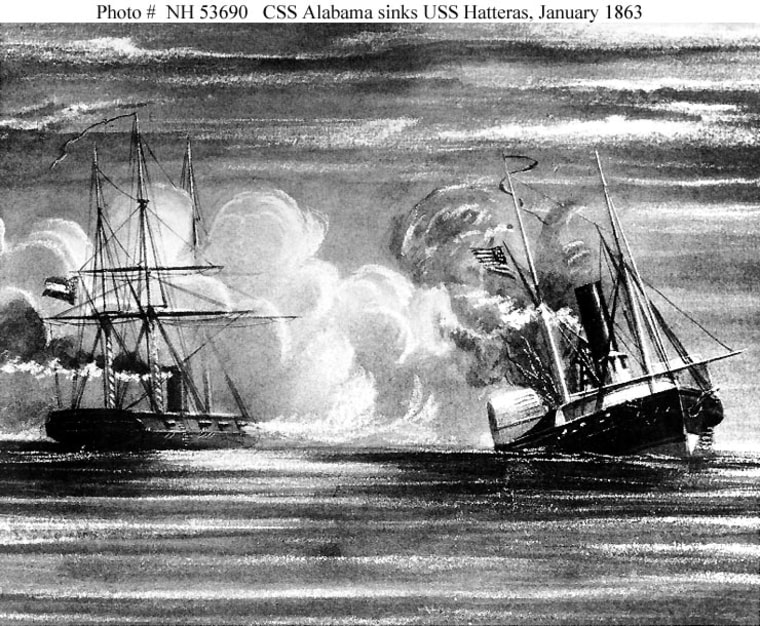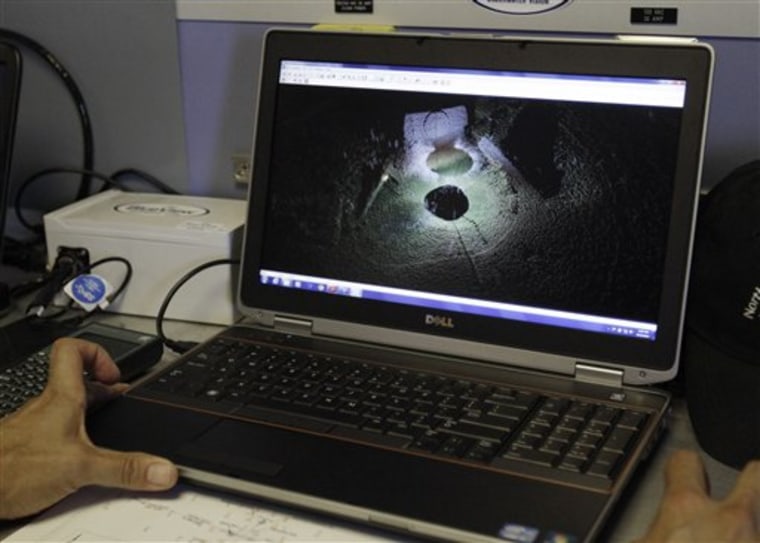The world will soon get its first good look at the wreckage of the only U.S. Navy ship sunk in combat in the Gulf of Mexico during the Civil War, thanks to sophisticated 3-D sonar images that divers have been collecting this week in the Gulf's murky depths.
The USS Hatteras, an iron-hulled 210-foot (64-meter) ship that sank about 20 miles (32 kilometers) off the coast of Galveston, Texas, in January 1863, has sat mostly undisturbed and unnoticed since its wreckage was found in the early 1970s. But recent storm-caused shifts in the seabed where the Hatteras rests 57 feet (17 meters) below the surface have exposed more of it to inspection, and researchers are rushing to get as complete an image of the ship as possible before the sand and silt shifts back.
"You can mark Gettysburg or Manassas, [but] how do you mark a battlefield in the sea?" said Jim Delgado, the director of maritime heritage for the National Oceanic and Atmospheric Administration's Office of National Marine Sanctuaries, and the person overseeing the project.
On Monday, a team of archaeologists and technicians began two days of scanning the wreckage using a sonar imaging technology that hadn't been used yet at sea, Delgado said.
Aboard the research vessel, Manta, researcher Christopher Horrell gleefully pored over computer images of the Hatteras' stern and paddlewheels that had just been transmitted from the seafloor.
"This is what I got into archaeology for. It's fantastic," Horrell, a senior marine archaeologist for the Department of the Interior, said Monday.
3-D scanning devices
The images, taken by a roughly 2-foot-long (60-centimeter-long) cylindrical device deposited near the wreckage, were used to position divers who then used 3-D scanning devices to map the site. The sand and silt-filled water near the seafloor limited the divers' visibility to 3 to 10 feet (1 to 3 meters), and it makes filming or photographing the wreckage difficult. But it doesn't affect the sonar technology, which produces images by analyzing sound waves bouncing off objects, allowing scientists to capture a more complete look at the wreckage.
Delgado said he's hoping to post the images online for the public by January, in time for the 150th anniversary of the battle. He also hopes researchers will review the images to look for ways to preserve the wreckage.
"Whatever we can do to make it accessible," Delgado said. "We want to share this with folks and show people history is real."
The wreckage site was discovered in the early 1970s by a Rice University professor, according to Amy Borgens, the Texas state marine archaeologist. "We knew it was here but didn't know exactly," she said. "One of the problems with shipwrecks is you can't take people down there to show them. And there's all this drama with shipwrecks, which are almost always the result of a tragedy."
The Hatteras wreck is in waters administered by the federal Bureau of Ocean Energy Management, and the ship itself still remains property of the U.S. Navy.
Built in 1861
According to the Navy Historical Center, the 1,126-ton Hatteras was built in 1861 in Wilmington, Del., as a civilian steamship. Later that year, it was purchased by the Navy, commissioned at the Philadelphia Navy Yard and assigned to join the blockade of the Florida coast to keep vessels from delivering supplies and munitions to the Confederacy. It had an active tour, in Florida, raiding Cedar Keys, destroying at least seven schooners and facilities before being transferred to the Gulf.

On Jan. 6, 1863, it joined the fleet commanded by David Farragut, of "Damn the Torpedoes" fame, for similar assignments off Galveston. That was then the most prominent city and port in Texas, which had joined the Confederacy. Five days later, the Hatteras pursued and tracked down a three-masted ship that identified itself as British, but later opened fire from 25 to 200 yards (meters) away. The ship was revealed to be the CSS Alabama, a notorious Confederate raider.
Forty-three minutes later, with the Hatteras was burning and taking on water, Cmdr. Homer Blake surrendered, and he and his crew were taken aboard the Alabama as prisoners, eventually winding up in Jamaica. Of the 126-man crew, two were lost and are believed entombed in the wreck, which became the only Union warship sunk by a Confederate raider in the Gulf.
"It's hard to believe we're in the middle of a battlefield," said Ed Cotham, the project historian, who carried with him Monday an original photograph of Blake, a formal portrait showing the officer in his uniform. "It's the first time he's returned since January 1863."
Memorial service conducted
Before the work began, a wreath was placed in the Gulf, red and white rose petals were scattered on the water's surface and a priest, the Rev. Stephen Duncan, conducted a brief memorial service for the two crewmen, William Healy, 32, a coal heaver, and John Cleary, 24, a stoker, in what was likely the first religious service for them ever at the site.
Both men, from Ireland, probably were Catholic, he said. No relatives are known to be in the U.S. and it likely took years for their relatives back in the Civil War times to learn of their fate, he said.
The Alabama, which was credited with 60 kills, was eventually sunk thousands of miles away, when a Union ship attacked it in the English Channel in June 1864 after it underwent repairs in a French port.
